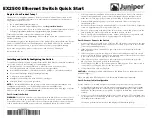
Falcon R-Class | User Guide
118
RADIUS attributes used in identifying a VLAN ID:
RFC2868 and RFC3580 form the basis for the attributes used in
identifying a VLAN ID in an Access-Accept packet. The following
criteria are used:
The Tunnel-Medium-Type, Tunnel-Type, and Tunnel-Private-Group-
IDattributes must all be present at least once in the Access-Accept
packet.
The switch looks for the first set of these attributes that have the same
Tag value and fulfil the following requirements (if Tag == 0 is used, the
Tunnel-Private-Group-ID does not need to include a Tag):
- Value of Tunnel-Medium-Type must be set to "IEEE-802" (ordinal 6).
- Value of Tunnel-Type must be set to "VLAN" (ordinal 13).
- Value of Tunnel-Private-Group-ID must be a string of ASCII chars in
the range '0' - '9', which is interpreted as a decimal string representing
the VLAN ID. Leading '0's are discarded. The final value must be in the
range [1; 4095].
Guest VLAN Enabled
When Guest VLAN is both globally enabled and enabled (checked) for
a given port, the switch considers moving the port into the Guest
VLAN
according
to
the
rules
outlined
below.
This option is only available for EAPOL-based modes, i.e.:
•
Port-based 802.1X
•
Single 802.1X
•
Multi 802.1X
For troubleshooting VLAN assignments, use the " →
VLANs
→
VLAN
Membership Status and VLAN Port Status" pages. These pages show
which modules have (temporarily) overridden the current Port VLAN
configuration.
Guest VLAN Operation:
When a Guest VLAN enabled port's link comes up, the switch starts
transmitting EAPOL Request Identity frames. If the number of
transmissions of such frames exceeds Max. Reauth. Count (refer to
System Configuration above) and no EAPOL frames have been
received in the meanwhile, the switch considers entering the Guest
VLAN. The interval between transmission of EAPOL Request Identity
frames is configured with EAPOL Timeout. If Allow Guest VLAN if
EAPOL Seen (refer to System Configuration above) is enabled, the port
will now be placed in the Guest VLAN. If disabled, the switch will first
check its history to see if an EAPOL frame has previously been received
on the port (this history is cleared if the port link goes down or the
port's Admin State is changed -Refer to Port Configuration), and if not,
the port will be placed in the Guest VLAN. Otherwise, it will not move
to the Guest VLAN, but continue transmitting EAPOL Request Identity
frames at the rate given by EAPOL Timeout.
Once in the Guest VLAN, the port is considered authenticated, and all
attached clients on the port are allowed access on this VLAN. The
switch will not transmit an EAPOL Success frame when entering the
Guest VLAN.
















































